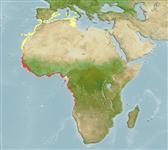Environment: milieu / climate zone / depth range / distribution range
ນິເວດວິທະຍາ
ສັດທະເລ; ນ້ຳກ່ອຍ ອາໄສຢູ່ໃກ້ໜ້າດິນໃຕ້ພື້ນທ້ອງນ້ຳ; ລະດັບຄວາມເລິກ 10 - 100 m (Ref. 10001). Subtropical; 44°N - 13°S, 18°W - 14°E (Ref. 128784)
Eastern Atlantic: Gibraltar and extreme western Mediterranean southward along the entire west coast of Africa to Angola, near Benguela.
ຂະໜາດ / ນ້ຳໜັກ / Age
Maturity: Lm ? range ? - ? cm
Max length : 80.0 cm TL ຕົວຜູ້/ບໍ່ມີເພດ; (Ref. 7059); common length : 55.0 cm TL ຕົວຜູ້/ບໍ່ມີເພດ; (Ref. 2683); ນ້ຳໜັກສູງສຸດທີ່ເຄຍຈັດພີມມາ: 4.3 kg (Ref. 4699)
Common in shallow coastal waters, also in estuaries (Ref. 2683), bays and lagoons, as well as in offshore trawling stations. Feeds on crabs, echinoids and mollusks (Ref. 10001). Occurs over hard substrate (Ref. 5377).
Life cycle and mating behavior
ການຈະເລີນເຕັມໄວ | ການສືບພັນ | ການວາງໄຂ່ | ໄຂ່ | ຄວາມດົກຂອງໄຂ່ປາ | ຕົວອ່ອນ
Shipp, R.L., 1990. Tetraodontidae. p. 1069-1072. In J.C. Quero, J.C. Hureau, C. Karrer, A. Post and L. Saldanha (eds.) Check-list of the fishes of the eastern tropical Atlantic (CLOFETA). JNICT, Lisbon; SEI, Paris; and UNESCO, Paris. Vol. 2. (Ref. 7464)
IUCN Red List Status (Ref. 130435: Version 2024-1)
Threat to humans
Harmless
Human uses
ການປະມົງ: ເປັນສີນຄ້າ; ຊະນິດປາທີ່ຖືກນຳໃຊ້ເຂົ້າໃນການຫາເພື່ອເປັນເກມກິລາ: ແມ່ນ
ເຄື່ອງມື
Special reports
Download XML
ແຫຼ່ງອີນເຕີເນັດ
Estimates based on models
Preferred temperature (Ref.
123201): 19.2 - 27.9, mean 25.7 °C (based on 86 cells).
Phylogenetic diversity index (Ref.
82804): PD
50 = 1.0000 [Uniqueness, from 0.5 = low to 2.0 = high].
Bayesian length-weight: a=0.01622 (0.00726 - 0.03621), b=2.92 (2.74 - 3.10), in cm total length, based on LWR estimates for this (Sub)family-body shape (Ref.
93245).
ຊັ້ນເຂດຮ້ອນ (Ref.
69278): 3.6 ±0.53 se; based on food items.
ຄວາມຢືດຢຸ່ນ (Ref.
120179): ຂະໜາດກາງ, ປະຊາກອນຕຳ່ສຸດທີ່ໃຊ້ເວລາສອງເທົ່າ 1.4 - 4.4 ປີ (Preliminary K or Fecundity.).
Fishing Vulnerability (Ref.
59153): Moderate to high vulnerability (52 of 100).
Nutrients (Ref.
124155): Calcium = 51.9 [17.6, 122.7] mg/100g; Iron = 0.96 [0.54, 1.98] mg/100g; Protein = 19.1 [17.0, 21.3] %; Omega3 = 0.374 [0.175, 0.735] g/100g; Selenium = 30.7 [16.8, 64.2] μg/100g; VitaminA = 8.44 [3.70, 19.02] μg/100g; Zinc = 0.725 [0.529, 1.009] mg/100g (wet weight);
